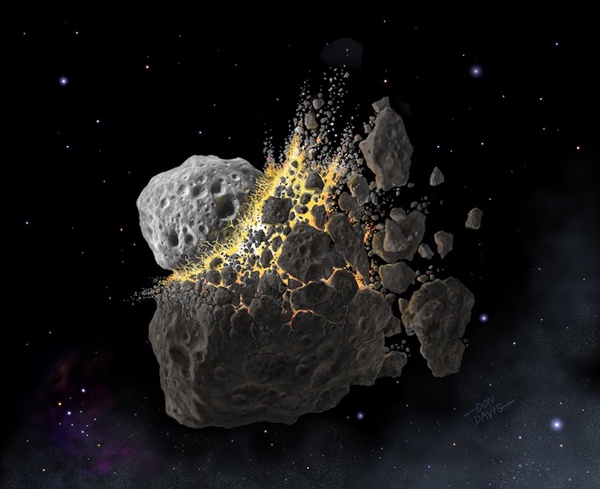Researchers have discovered an ancient asteroid collision sparked an ice age by blasting masses of dust into the atmosphere.
446 million years ago, the Earth experienced a period of global cooling. The poles started to freeze, and life flourished as evolving species adapted to the gradually decreasing temperatures.
For the first time, researchers from the Field Museum and Lund University in Sweden have discovered what triggered this ice age. The culprit was dust from a 93-mile wide asteroid between Mars and Jupiter that broke apart around the same time as temperatures started dropping.
Dust from outer space is continuously finding its way to Earth, but in such small quantities that there is little impact on the planet’s climate systems. 446 million years ago, though, it was a different story.
“Normally, Earth gains about 40,000 tons of extraterrestrial material every year,” said Philipp Heck, a member of the research team. “Imagine multiplying that by a factor of a thousand or ten thousand. Our hypothesis is that the large amounts of extraterrestrial dust over a timeframe of at least two million years played an important role in changing the climate on Earth, contributing to cooling.”
“Our results show for the first time that such dust, at times, has cooled Earth dramatically,” says Birger Schmitz of Sweden’s Lund University, the study’s lead author and a research associate at the Field Museum. “Our studies can give a more detailed, empirical-based understanding of how this works, and this in turn can be used to evaluate if model simulations are realistic.”
To figure it out, researchers looked for traces of space dust in 466-million-year-old rocks, and compared it to tiny micrometeorites from Antarctica as a reference. “We studied extraterrestrial matter, meteorites and micrometeorites, in the sedimentary record of Earth, meaning rocks that were once sea floor,” says Heck. “And then we extracted the extraterrestrial matter to discover what it was and where it came from.”
Extracting the extraterrestrial matter — the tiny meteorites and bits of dust from outer space — involves taking the ancient rock and treating it with acid that eats away the stone and leaves the space stuff. The team then analyzed the chemical makeup of the remaining dust. The team also analyzed rocks from the ancient seafloor and looked for elements that rarely appear in Earth rocks and for isotopes — different forms of atoms — that show hallmarks of coming from outer space. For instance, helium atoms normally have two protons, two neutrons, and two electrons, but some that are shot out of the Sun and into space are missing a neutron. The presence of these special helium isotopes, along with rare metals often found in asteroids, proves that the dust originated from space.
Other scientists had already established that our planet was undergoing an ice age around this time. The amount of water in the Earth’s oceans influences the way that rocks on the seabed form, and the rocks from this time period show signs of shallower oceans — a hint that some of the Earth’s water was trapped in glaciers and sea ice. Schmitz and his colleagues are the first to show that this ice age syncs up with the extra dust in the atmosphere. “The timing appears to be perfect,” he says. The extra dust in the atmosphere helps explain the ice age — by filtering out sunlight, the dust would have caused global cooling.
Since the dust floated down to Earth over at least two million years, the cooling was gradual enough for life to adapt and even benefit from the changes. An explosion of new species evolved as creatures adapted for survival in regions with different temperatures.
Heck notes that while this period of global cooling proved beneficial to life on Earth, fast-paced climate change can be catastrophic. “In the global cooling we studied, we’re talking about timescales of millions of years. It’s very different from the climate change caused by the meteorite 65 million years ago that killed the dinosaurs, and it’s different from the global warming today — this global cooling was a gentle nudge. There was less stress.”
It’s tempting to think that today’s global warming could be solved by replicating the dust shower that triggered global cooling 466 million years ago. But Heck says he would be cautious: “Geoengineering proposals should be evaluated very critically and very carefully, because if something goes wrong, things could become worse than before.”
While Heck isn’t convinced that we’ve found the solution to climate change, he says it’s a good idea for us to be thinking along these lines.
“We’re experiencing global warming, it’s undeniable,” says Heck. “And we need to think about how we can prevent catastrophic consequences, or minimize them. Any idea that’s reasonable should be explored.”















